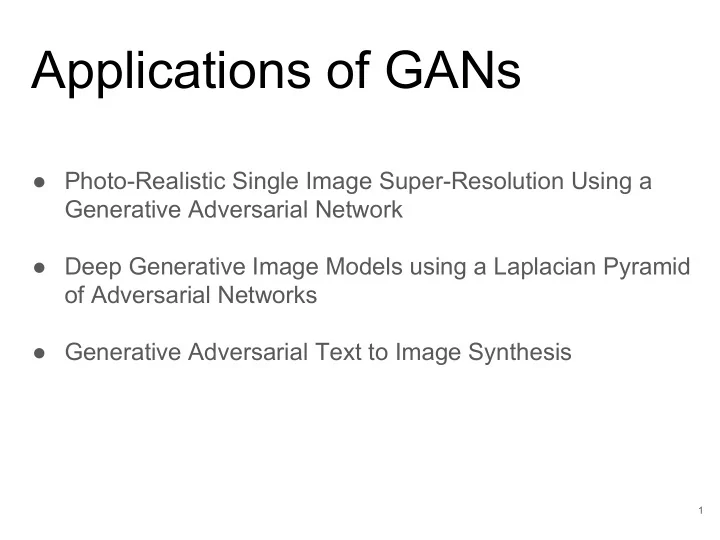

Applications of GANs ● Photo-Realistic Single Image Super-Resolution Using a Generative Adversarial Network ● Deep Generative Image Models using a Laplacian Pyramid of Adversarial Networks ● Generative Adversarial Text to Image Synthesis 1
Using GANs for Single Image Super-Resolution Christian Ledig, Lucas Theis, Ferenc Huszar, Jose Caballero, Andrew Aitken, Alykhan Tejani, Johannes Totz, Zehan Wang, Wenzhe Shi 2
Problem How do we get a high resolution (HR) image from just one (LR) lower resolution image? Answer: We use super-resolution (SR) techniques. http://www.extremetech.com/wp-content/uploads/2012/07/super-resolution-freckles.jpg 3
Previous Attempts 4
SRGAN 5
SRGAN - Generator G: generator that takes a low-res image I LR and outputs its high-res ● counterpart I SR ● θ G : parameters of G, {W 1:L , b 1:L } l SR : loss function measures the difference between the 2 high-res images ● 6
SRGAN - Discriminator D: discriminator that classifies whether a high-res image is I HR or I SR ● ● θ D : parameters of D 7
SRGAN - Perceptual Loss Function Loss is calculated as weighted combination of: Content loss ➔ Adversarial loss ➔ Regularization loss ➔ 8
SRGAN - Content Loss Instead of MSE, use loss function based on ReLU layers of pre-trained VGG network. Ensures similarity of content. � i,j : feature map of j th convolution before i th maxpooling ● ● W i,j and H i,j : dimensions of feature maps in the VGG 9
SRGAN - Adversarial Loss Encourages network to favour images that reside in manifold of natural images. 10
SRGAN - Regularization Loss Encourages spatially coherent solutions based on total variations. 11
SRGAN - Examples 12
SRGAN - Examples 13
Deep Generative Image Models using a Laplacian Pyramid of Adversarial Networks Work by Emily Denton, Soumith Chintala, Arthur Szlam, Rob Fergus 14
Short Background 15
Conditional Generative Adversarial Nets (CGAN) Mirza and Osindero (2014) GAN CGAN 16
Laplacian pyramid Burt and Adelson (1983) 17
Laplacian pyramid Burt and Adelson (1983) 18
Laplacian Pyramid Generative Adversarial Network (LAPGAN) 19
Image Generation 20
Training 21
Generation: Coarse to fine 22
Different draws, starting from the same initial 4x4 image 23
Some thoughts on the method ● The Laplacian Pyramid Framework is independent of the Generative Model Possible to use a completely different model like Pixel RNN 24
Some thoughts on the method ● The Generative Models at each step can be totally different! These can also be different models! 25
Some thoughts on the method ● The Generative Models at each step can be totally different! High resolution architecture Low resolution architecture 26
Generative Adversarial Text to Image Synthesis Scott Reed, Zeynep Akata, Xinchen Yan, Lajanugen Logeswaran, Bernt Schiele, Honglak Lee Author’s code available at: https://github.com/reedscot/icml2016 27
Motivation Current deep learning models enable us to... ➢ Learn feature representations of images & text ➢ Generate realistic images & text pull out images based on captions generate descriptions based on images answer questions about image content 28
Problem - Multimodal distribution • Many plausible image can be associated with one single text description • Previous attempt uses Variational Recurrent Autoencoders to generate image from text caption but the images were not realistic enough. (Mansimov et al. 2016) 29
What GANs can do • CGAN: Use side information (eg. classes) to guide the learning process • Minimax game: Adaptive loss function ➢ Multi-modality is a very well suited property for GANs to learn. 30
The Model - Basic CGAN Learns a compatibility Pre-trained char-CNN-RNN function of images and text -> joint embedding 31
The Model - Variations GAN-CLS Algorithm In order to distinguish different error sources: Present to the discriminator network 3 different types of input. (instead of 2) 32
The Model - Variations cont. GAN-INT Updated Equation In order to generalize the output of G: Interpolate between training set embeddings to generate new text and hence fill the gaps {fake image, fake text} on the image data manifold. GAN-INT-CLS: Combination of both previous variations 33
Disentangling ❖ Style is background, position & orientation of the object, etc. ❖ Content is shape, size & colour of the object, etc. ● Introduce S(x), a style encoder with a squared loss function: ● Useful in generalization: encoding style and content separately allows for different new combinations 34
Training - Data (separated into class-disjoint train and test sets) Caltech-UCSD Birds MS COCO Oxford Flowers 35
Training – Results: Flower & Bird 36
Mansimov et al. Training – Results: MS COCO 37
Training – Results Style disentangling 38
Thoughts on the paper • Image quality • Generalization • Future work 39
Recommend
More recommend